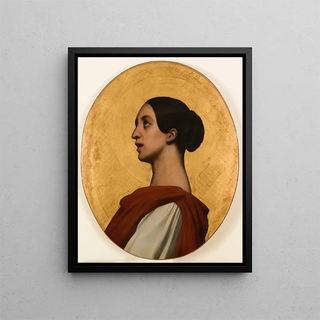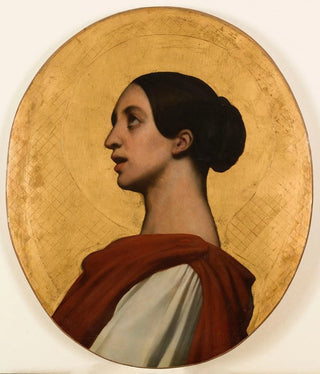Art print | Portrait of Pauline Viardot as Saint Cecilia - Ary Scheffer


View from behind

Frame (optional)
At the heart of the 19th century, an iconic art print emerges, capturing the essence of an era where art and music intertwine harmoniously. The "Art print of Pauline Viardot as Saint Cecilia" by Ary Scheffer is much more than a simple depiction of a renowned singer; it embodies the spirit of a time when culture and aesthetics blend with unparalleled delicacy. This painting, rich in emotion and symbolism, immerses us in the world of music and spirituality through the lens of a strong and inspiring female figure. The beauty of this art print lies not only in the artist's technical mastery but also in the psychological depth emanating from Pauline Viardot's gaze, evoking both melancholy and grace.
Style and uniqueness of the work
Ary Scheffer's style is distinguished by its poignant romanticism, where each brushstroke seems infused with intense passion. In this art print, light plays a crucial role, illuminating Viardot's face in a way that enhances her beauty and dignity. The drapery of her dress, carefully rendered, creates a fascinating contrast with the dark background, thus emphasizing the singer's almost divine presence. Pauline's posture, evoking the holiness of Saint Cecilia, exudes an aura of serenity and strength, making this piece a true hymn to femininity and art. The meticulous details, such as accessories and color nuances, testify to a scrupulous attention to the elements that compose the visual identity of this masterpiece. This art print does not merely depict a historical figure; it invites the viewer to deep contemplation, to reflect on the place of art in human life.
The artist and his influence
Ary Scheffer, an emblematic figure of French Romanticism, knew how to mark his era with works filled with emotion and spirituality. His artistic journey is punctuated by encounters with influential personalities of his time, including writers, musicians, and other artists. By choosing to paint Pauline Viardot, Scheffer does not simply...

Matte finish

View from behind

Frame (optional)
At the heart of the 19th century, an iconic art print emerges, capturing the essence of an era where art and music intertwine harmoniously. The "Art print of Pauline Viardot as Saint Cecilia" by Ary Scheffer is much more than a simple depiction of a renowned singer; it embodies the spirit of a time when culture and aesthetics blend with unparalleled delicacy. This painting, rich in emotion and symbolism, immerses us in the world of music and spirituality through the lens of a strong and inspiring female figure. The beauty of this art print lies not only in the artist's technical mastery but also in the psychological depth emanating from Pauline Viardot's gaze, evoking both melancholy and grace.
Style and uniqueness of the work
Ary Scheffer's style is distinguished by its poignant romanticism, where each brushstroke seems infused with intense passion. In this art print, light plays a crucial role, illuminating Viardot's face in a way that enhances her beauty and dignity. The drapery of her dress, carefully rendered, creates a fascinating contrast with the dark background, thus emphasizing the singer's almost divine presence. Pauline's posture, evoking the holiness of Saint Cecilia, exudes an aura of serenity and strength, making this piece a true hymn to femininity and art. The meticulous details, such as accessories and color nuances, testify to a scrupulous attention to the elements that compose the visual identity of this masterpiece. This art print does not merely depict a historical figure; it invites the viewer to deep contemplation, to reflect on the place of art in human life.
The artist and his influence
Ary Scheffer, an emblematic figure of French Romanticism, knew how to mark his era with works filled with emotion and spirituality. His artistic journey is punctuated by encounters with influential personalities of his time, including writers, musicians, and other artists. By choosing to paint Pauline Viardot, Scheffer does not simply...






